Back to blog
15 MIN READ
14 Best Product Development Software for Every Team 2025
PUBLISHED
10 April, 2025

Product Analytics Expert
You’re managing roadmaps, collecting feedback, aligning teams, and trying to ship on time. It’s a lot. And without the right product development tools, things fall through the cracks—deadlines, ideas, even your sanity.
The good news? You don’t have to do it alone. Today’s best product development tools are built to support every stage of your workflow, from planning and backlog grooming to user feedback and analytics.
In this guide, you’ll find 14 practical tools that help product managers like you move faster, stay aligned, and build better products. Whether you're at a startup or scaling in an enterprise, there's something here for you.
Summary - Best product development software
| Tool | Best for |
|---|---|
| Jira | Agile backlog and issue-tracking |
| Asana | Streamlining project organization for cross-functional teams |
| Trello | Visual Kanban simplicity for lean teams |
| Aras Innovator | Open-source PLM for custom workflows |
| Siemens Teamcenter | Enterprise PLM at Scale |
| ProdPad | Roadmaps and ideas, all in one place |
| Planview | Portfolio and innovation management for enterprises |
| UXCam | Simple product analytics for web and mobile apps |
| Mixpanel | Event tracking and funnel analysis |
| Amplitude | Connecting product usage to retention and revenue |
| Canny | Crowdsourced feedback and feature request management |
| Upvoty | Lean feedback boards for growing teams |
| Productboard | Prioritizing and planning with customer insights |
| Aha! Roadmaps | Strategic roadmapping for enterprise teams |
| ProductPlan | Easy visual roadmaps for all teams |
Project management tools for product collaboration
Managing a product is a team sport. You’re balancing engineering timelines, stakeholder expectations, customer needs, and your roadmap—all while keeping everyone moving in the same direction. That’s where project management tools come in.
These tools act as the operational hub for product teams. Whether you’re planning sprints, updating your backlog, or tracking cross-functional initiatives, the right tool helps you stay on top of it all.
Which project management tools help product teams collaborate effectively?
Let’s look at three project collaboration tools that make product execution smoother, more transparent, and far less stressful.
1. Jira
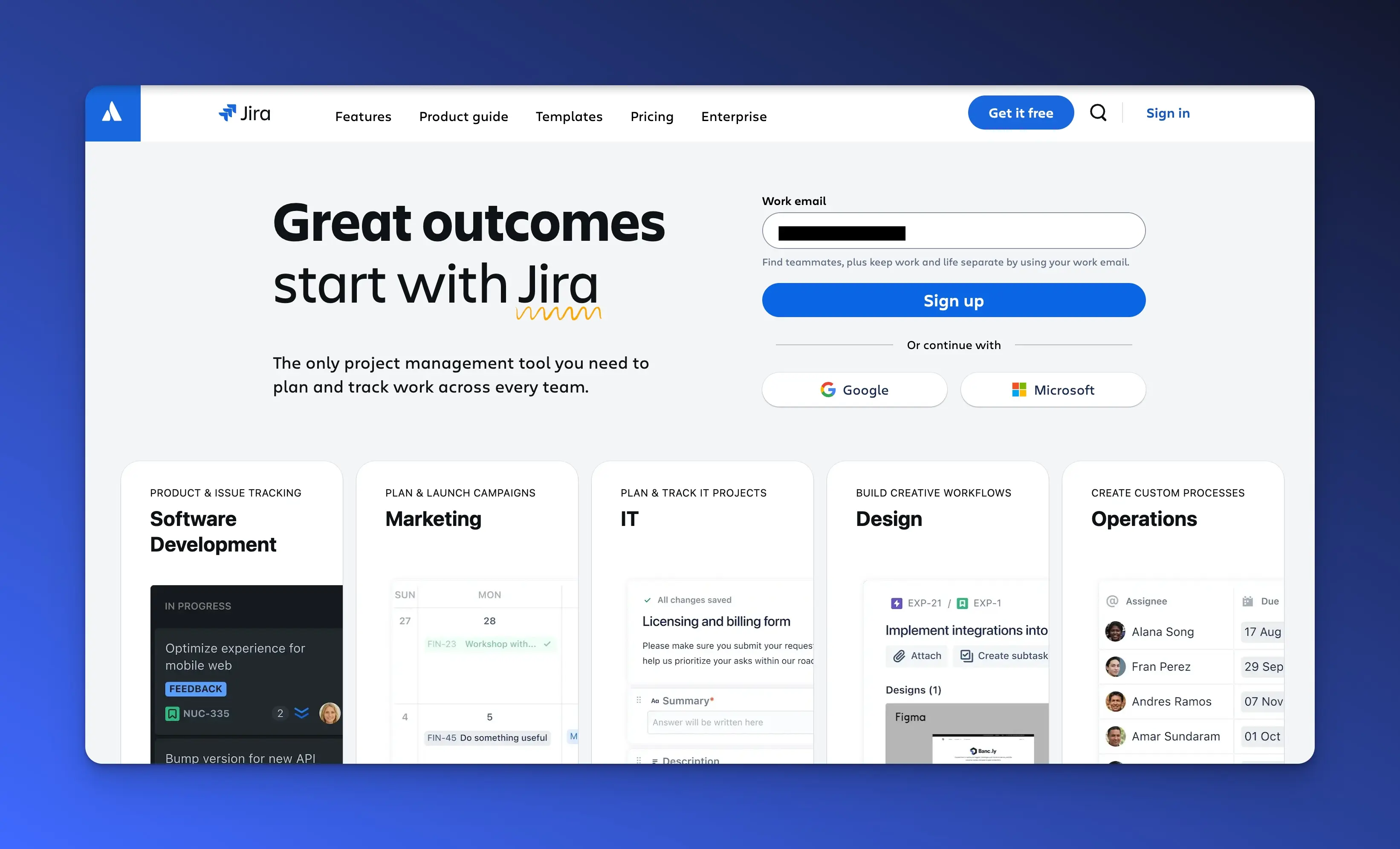
Best for: Agile backlog and issue-tracking
If you're managing an agile development team, Jira is likely already on your radar. It’s one of the most widely used product development tools for organizing sprints, managing the product backlog, and tracking issues in real time.
Jira supports both Scrum and Kanban boards, making it flexible for how your team works. It connects deeply with Git repositories and CI/CD tools, giving you full visibility from idea to deployment. You can track user stories, prioritize bugs, and view team velocity—all in one place.
Plus, the Jira Marketplace offers hundreds of integrations and add-ons, from roadmapping to reporting. Whether you're refining backlog items or planning your next release, Jira helps you stay structured without slowing down.
Top features:
Scrum and Kanban boards
Sprint planning and backlog grooming
Powerful filters and reports
Dev tool integrations for version control and CI/CD
Robust automation rules
Jira Pricing: Free for up to 10 users. Standard starts at $7.50/user/month. Premium and Enterprise tiers scale with advanced needs.
2. Asana
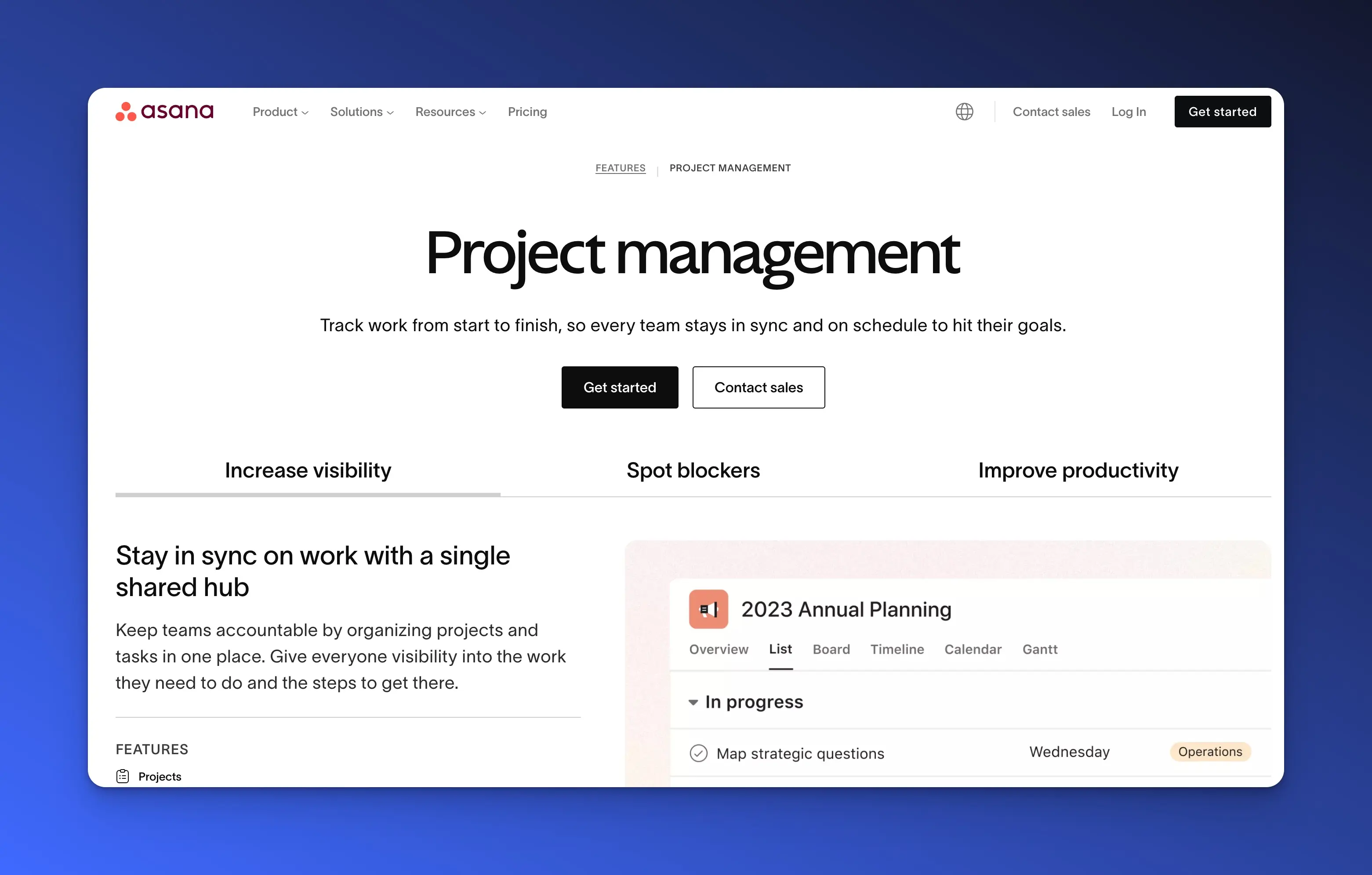
Best for: Streamlining project organization for cross-functional teams
Asana is a favorite among product managers who need a tool that plays nicely with everyone—from developers to designers to marketers. It's not built just for engineering; it's built for collaboration across functions.
With Asana, you can manage tasks using lists, boards, timelines, or calendars—whatever suits your team best. Assign responsibilities, set due dates, and add context using comments, file attachments, and project briefs. It’s ideal for planning product launches, tracking goals, and running cross-functional sprints.
One standout feature? Clarity. Asana gives everyone—from stakeholders to contributors—a clear view of who’s doing what by when, without needing extra meetings.
Top features:
Multiple project views (list, board, timeline, calendar)
Task assignments and due dates
Real-time collaboration with comments and file sharing
Goals and workload tracking
Project templates and automation
Asana Pricing: Free for small teams. Premium starts at $10.99/user/month. Business and Enterprise tiers unlock additional automation, reporting, and security features.
3. Trello
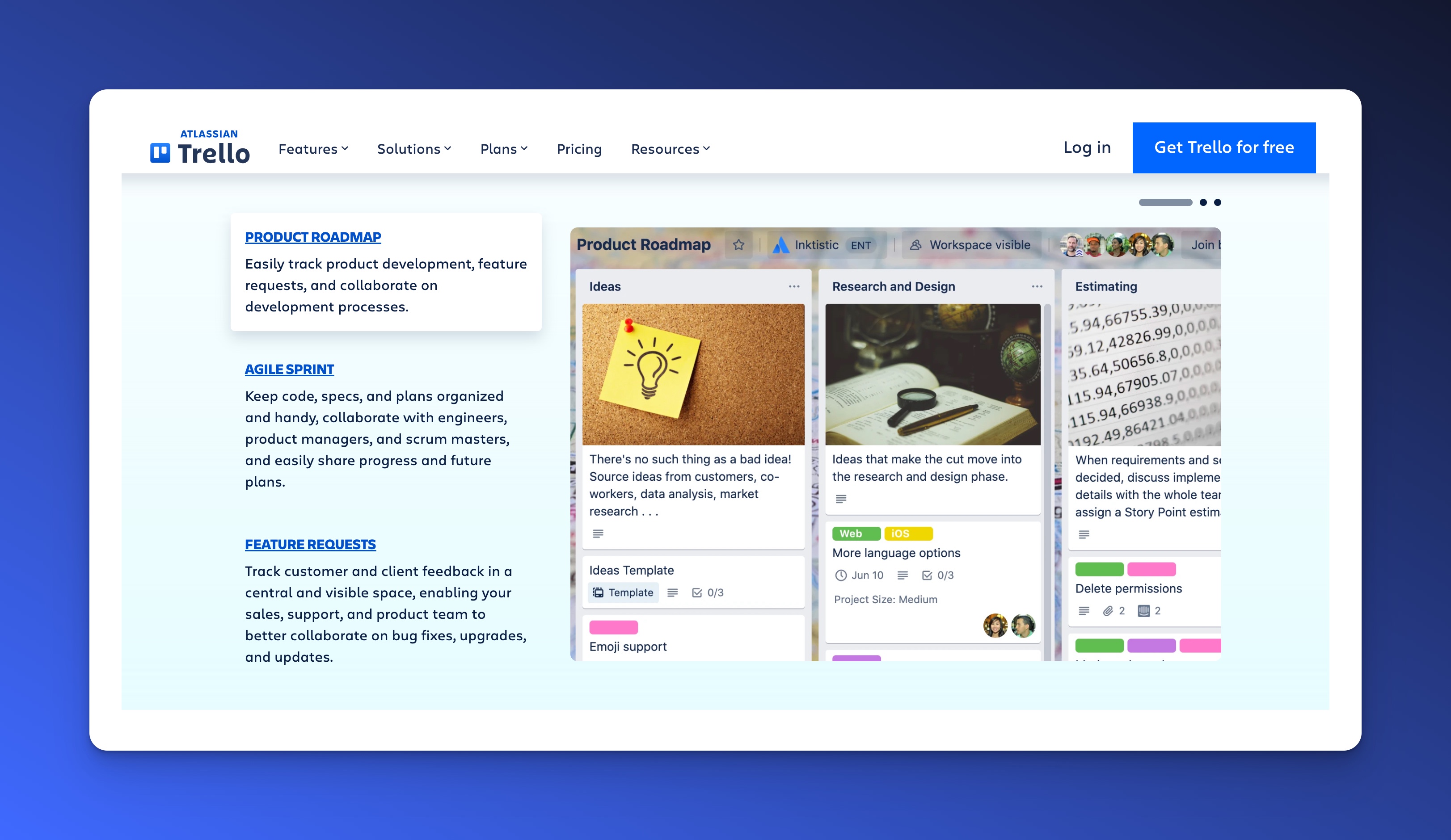

Best for: Visual Kanban simplicity for lean teams
Trello keeps things simple. It’s perfect for teams who don’t need all the complexity of a full project management suite but still want to stay organized. Trello uses drag-and-drop Kanban boards that anyone can learn in minutes.
Whether you're tracking a content calendar, sprint tasks, or onboarding checklists, Trello makes it easy to visualize your workflow. You can enhance your boards with Power-Ups—Trello’s version of integrations—for calendars, custom fields, and tools like Slack or Google Drive.
It’s a great fit for startups and small teams who want visual clarity without the overhead.
Top features:
Easy-to-use Kanban boards
Checklists, labels, and due dates on cards
Drag-and-drop task management
Power-Ups for calendar view, custom fields, integrations
Mobile app for on-the-go updates
Trello Pricing: Free core plan (up to 10 boards). Standard at $5/user/month, Premium at $10/user/month, and Enterprise plans from $17.50/user/month.
PLM Tools for full lifecycle management
When you're building more than just software—think hardware, manufacturing, or complex systems—you need more than task tracking. You need full visibility over the entire product lifecycle.
Product Lifecycle Management (PLM) tools help you manage everything from early concept designs to engineering changes, production, and beyond. They give your team a shared source of truth, especially when multiple departments, tools, and file types are involved.
What product lifecycle management (PLM) tools support end-to-end development?
Let’s look at two top PLM tools that help product teams keep complexity under control.
4. Aras Innovator
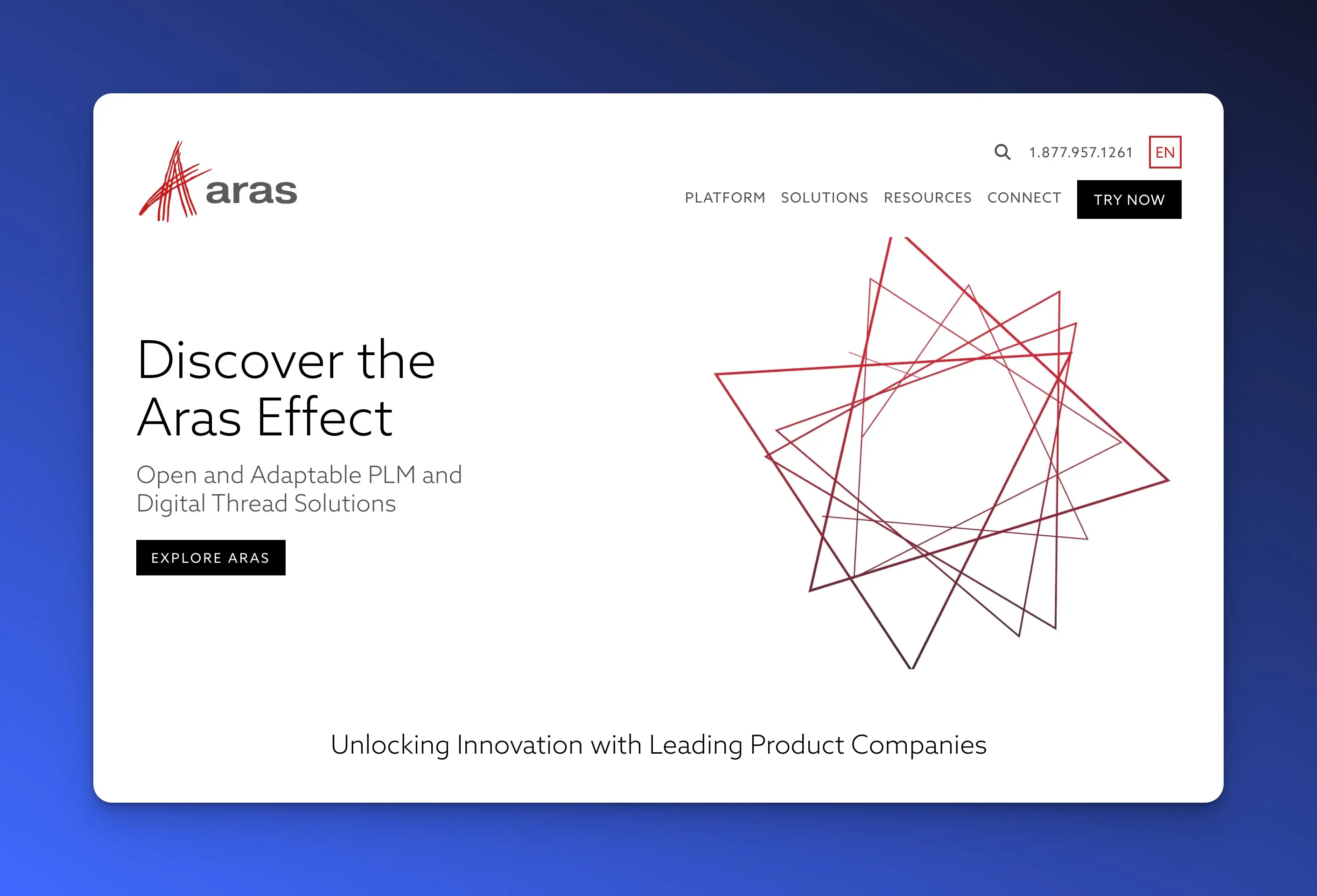
Best for: Open-source PLM for custom workflows
If your team has unique product development processes that don’t fit into a one-size-fits-all solution, Aras Innovator gives you the flexibility to build your own PLM system, without starting from scratch.
It’s open-source and incredibly configurable, letting you tailor workflows, data models, and permissions to your exact needs. That makes it great for mid-sized or growing teams who need powerful lifecycle management without the high cost of enterprise licenses.
Aras supports everything from BOM management to change tracking, and it integrates well with engineering and manufacturing workflows.
Top features:
Fully customizable data models and workflows
End-to-end product lifecycle tracking
Document management and version control
BOM (Bill of Materials) configuration
Quality and compliance tracking
Aras Pricing: Community Edition is free (self-hosted). Enterprise plans with support and hosting are priced on request.
5. Siemens Teamcenter
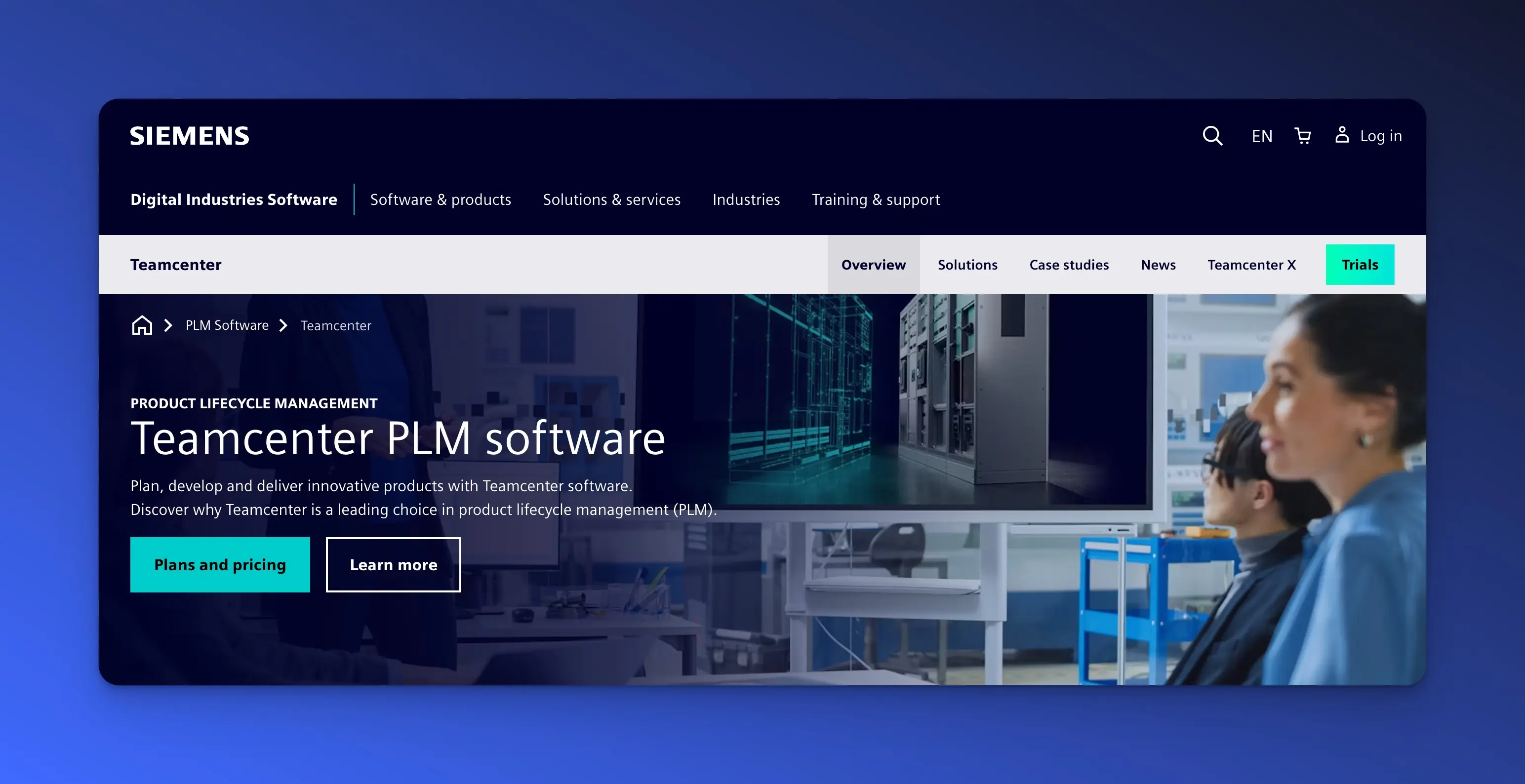
Best for: Enterprise PLM at Scale
Teamcenter by Siemens is built for large enterprises that develop complex products, automotive, aerospace, industrial equipment, you name it.
It acts as a central source of truth for every department involved in product development, from engineering and design to compliance and supply chain. It’s all about traceability, consistency, and tight integration with CAD and ERP tools.
If your teams are spread out or your product involves multiple subsystems, Teamcenter keeps everyone aligned—while helping manage changes, variants, and approvals.
Top features:
Enterprise-grade requirements and change management
Deep CAD, ERP, and manufacturing tool integrations
Secure version control and access permissions
Advanced product configuration management
Full traceability across product development
Siemens Teamcenter Pricing: Custom enterprise pricing (based on deployment scale, integrations, and users). Typically used by large organizations with dedicated implementation support.
NPD Tools for Early-Stage Innovation
Every great product starts with an idea—but not every idea turns into a great product. That’s where New Product Development (NPD) tools come in.
These platforms help you collect, evaluate, and prioritize ideas before they ever hit your roadmap. They’re built to streamline early-stage innovation, support cross-functional input, and ensure your team is working on ideas that actually matter.
How can teams manage new product development (NPD) more efficiently?
Here are two new product development (NPD) tools that help product managers turn concepts into action.
6. ProdPad
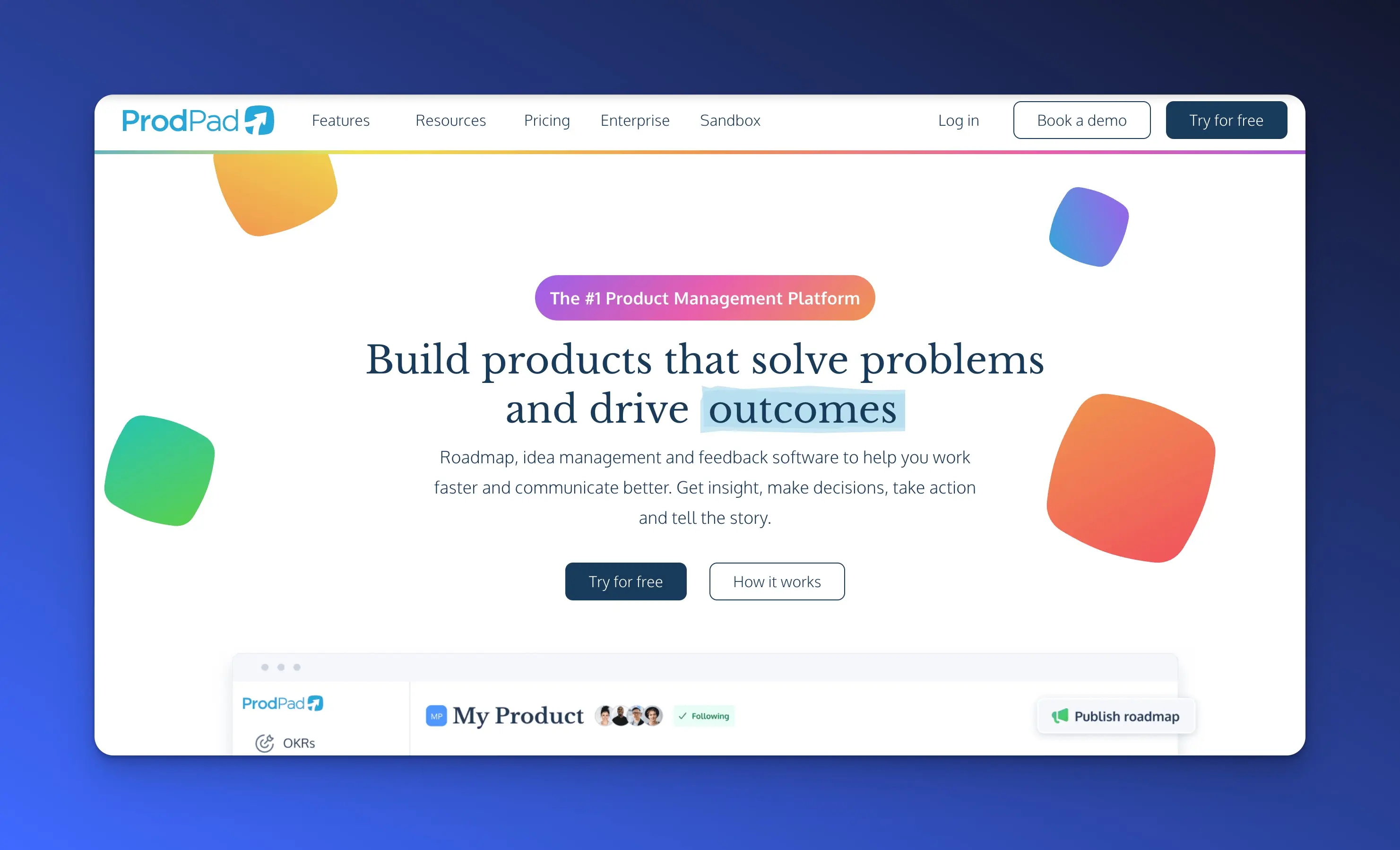
Best for: Roadmaps and ideas, all in one place
ProdPad is built to help product managers manage the messy, exciting front end of innovation. It gives you a central place to collect ideas, evaluate feedback, and shape a customer-informed product roadmap.
You can link user feedback to product ideas, score them based on business impact, and plan releases with confidence. Its visual roadmap builder makes it easy to communicate what's coming—and why—with internal teams and stakeholders.
It’s ideal for product teams that want to stay transparent, organized, and aligned with user needs.
Top features:
Centralized idea backlog with team and customer input
Prioritization scorecards and impact vs. effort matrix
Visual roadmap builder with drag-and-drop planning
Feedback collection tied to product features
OKR and initiative tracking
ProdPad Pricing: Free trial available. Paid plans start around $24/editor/month. Full-featured packages range from ~$149 to $399/month based on modules and team size.
7. Planview
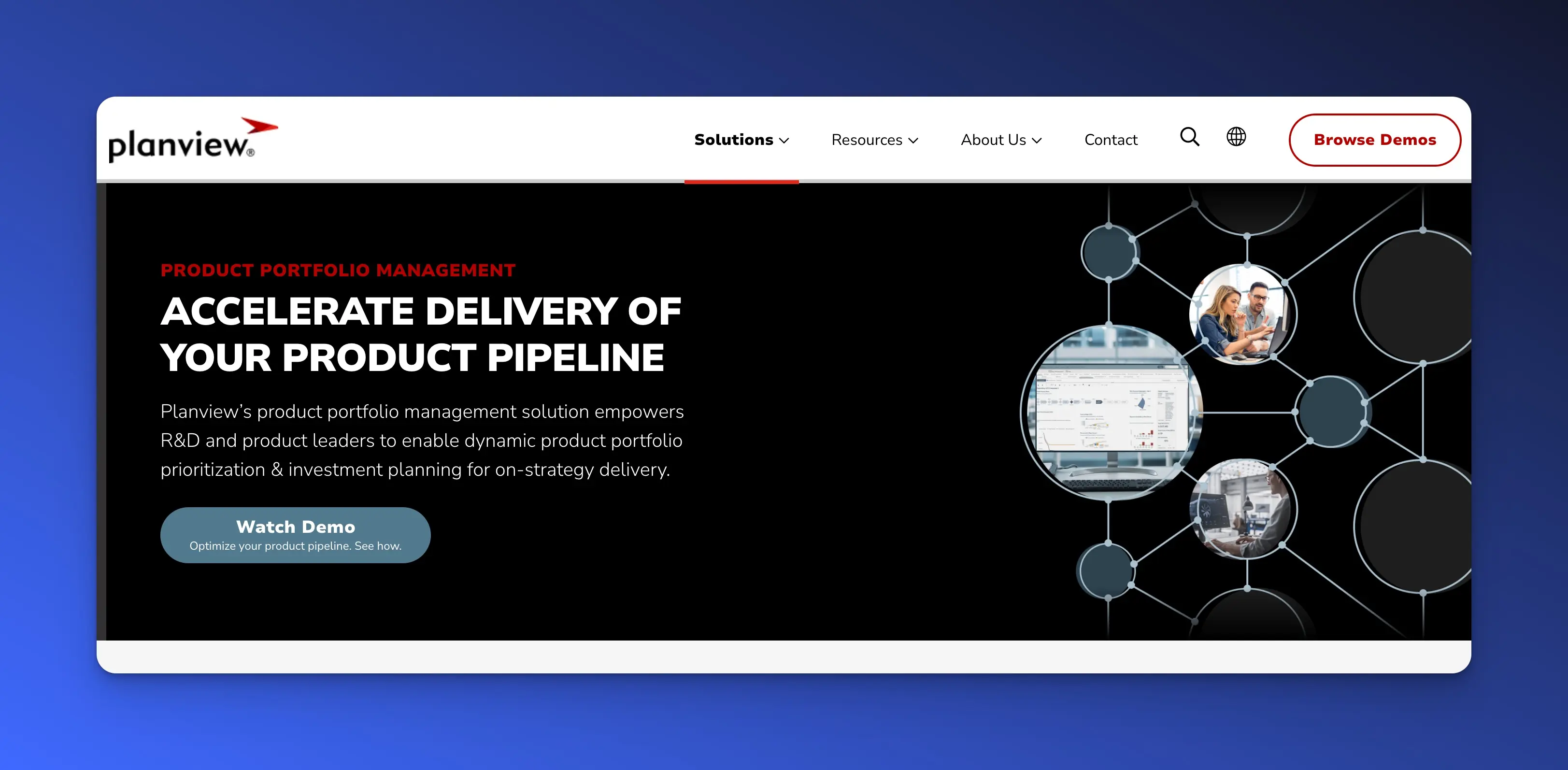
Best for: Portfolio and innovation management for enterprises
If you’re running multiple product lines or innovation initiatives across teams, Planview helps you stay in control at the portfolio level.
Planview is more than a tool—it’s a framework. It supports structured innovation with stage-gate processes, idea scoring, strategic alignment, and resource planning. You can simulate different project scenarios, track outcomes, and present clear dashboards to leadership.
It’s built for enterprises that want to innovate at scale without losing visibility or accountability.
Top features:
Stage-gate process support for idea-to-launch workflows
Portfolio-level visibility and scenario planning
Executive dashboards and strategic alignment
Idea intake and scoring
Capacity and resource planning
Planview Pricing: Custom enterprise pricing based on team size and modules used. Typically deployed by large product organizations or R&D-heavy companies.
Product analytics tools for user behavior insights
Shipping features is only half the job. The other half? Understanding how users interact with what you’ve built.
Product analytics tools help you make informed decisions based on real user behavior. They show what’s working, what’s not, and where users are dropping off—so you can fix issues, improve flows, and build better products faster.
Whether you're optimizing a signup funnel or validating a new feature, these tools give you the data to back up your decisions.
What product analytics tools offer deep user insights?
Let’s look at three analytics platforms that help product teams unlock valuable user insights—starting with a powerful one that works for both mobile and web.
8. UXCam
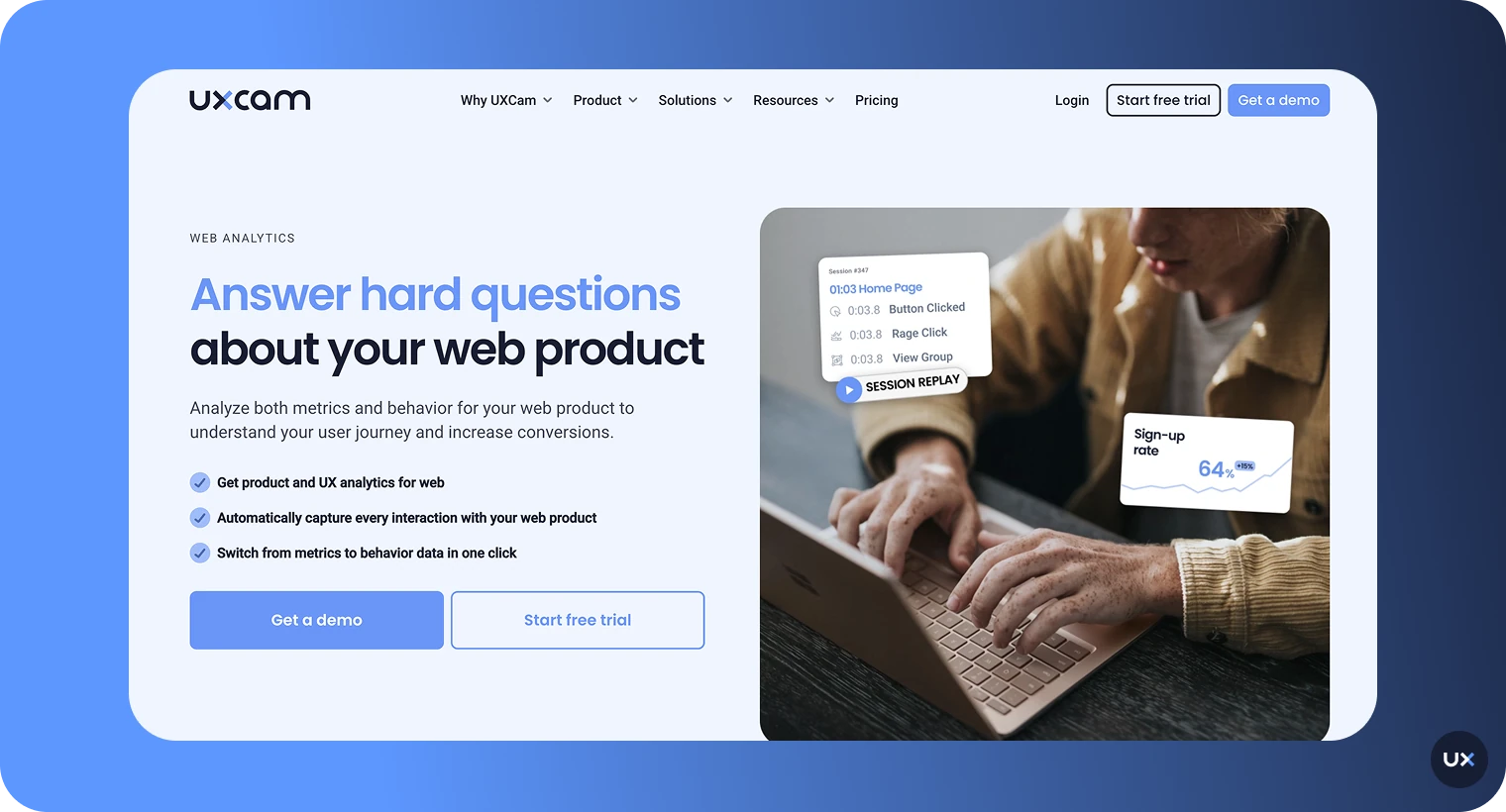
Best for: Simple product analytics for web and mobile apps
UXCam is a powerful yet easy-to-use product analytics tool that helps you truly understand how users interact with your web or mobile app. Instead of just giving you charts and numbers, it shows you the full user journey—so you can see where people tap, scroll, get stuck, or drop off.
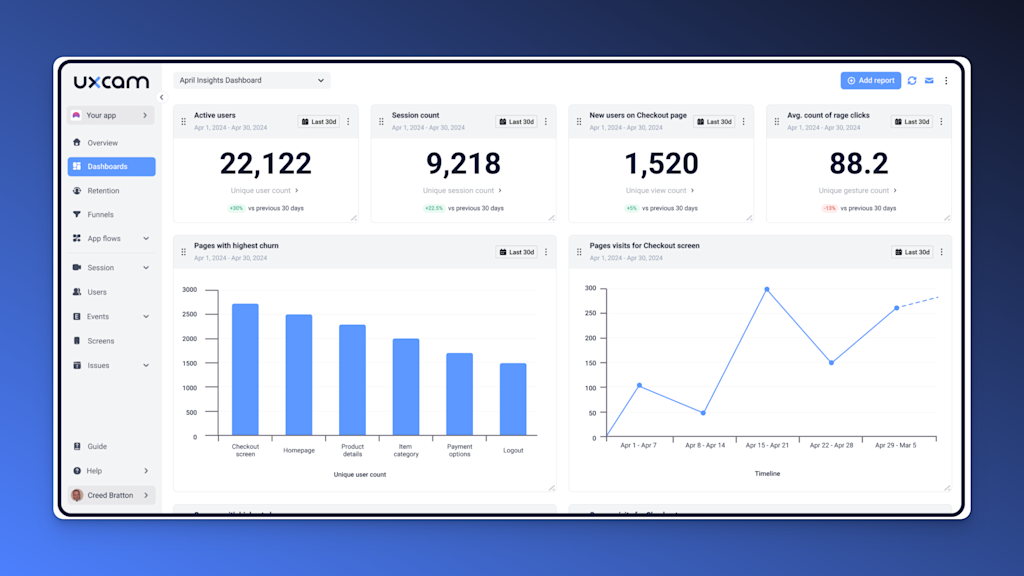

It combines session replays, heatmaps, and conversion funnels to give product managers the full picture, from high-level patterns to detailed user behavior. If users are rage tapping, abandoning flows, or missing key features, UXCam helps you spot it instantly—without needing to guess why.
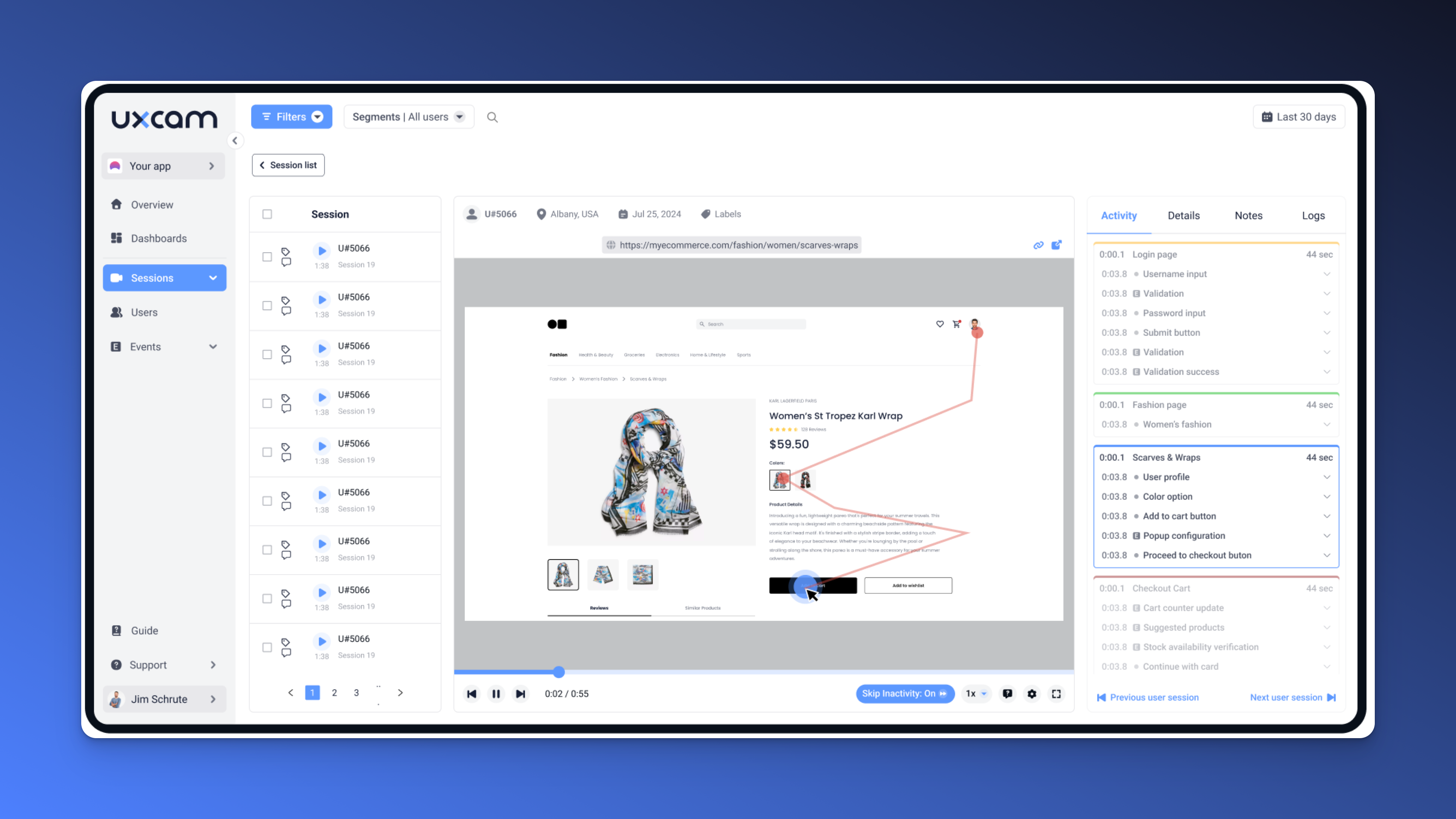

What makes UXCam stand out is its simplicity. It’s designed to be intuitive for product teams who want insights quickly without needing a data analyst to interpret dashboards. You get both qualitative and quantitative insights in one place, helping you make smarter decisions, fix issues faster, and improve the user experience continuously.
Whether you're validating a new feature, optimizing onboarding, or spotting friction points, UXCam brings visibility and clarity into your product. It’s especially useful for teams working on mobile apps, but also supports web apps—making it a versatile option for modern product teams that need answers, not just data.
This makes it an ideal solution for product managers who want both quantitative data and qualitative context to inform decisions.
Top features:
Session replays for mobile and web apps
Conversion funnels with visual drop-off analysis
User journey mapping across screens and actions
Automatic tagging for rage taps, UI freezes, and gestures
Segmentation by user type, device, or behavior
Pricing: Free plan with limited session volume. Custom pricing for Growth and Enterprise plans. 14-day free trial available.
What customer say about UXCam
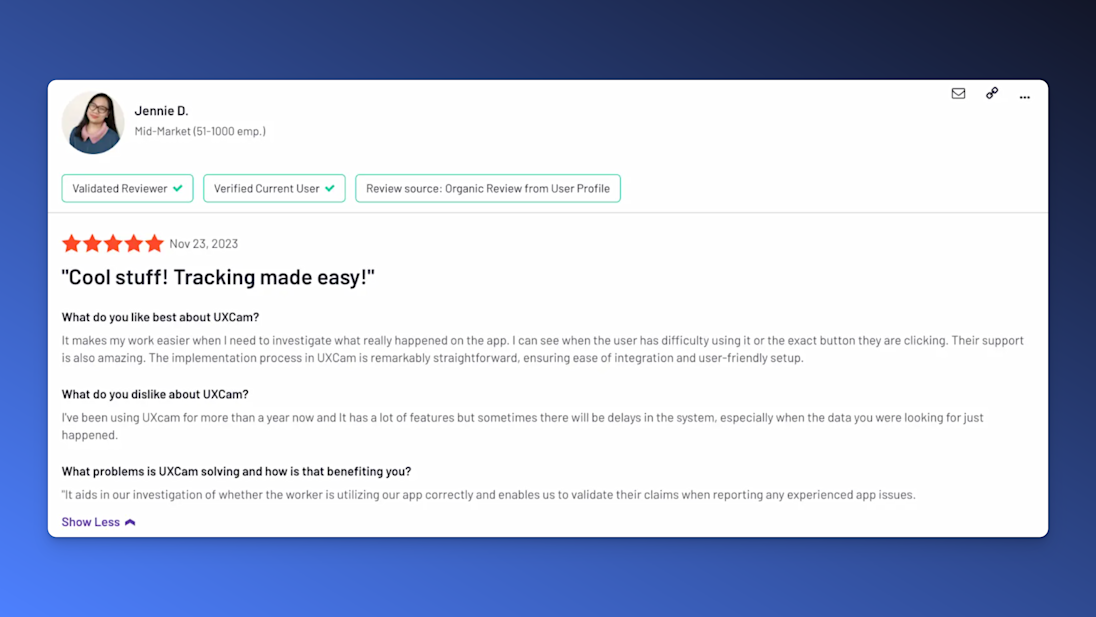

9. Mixpanel
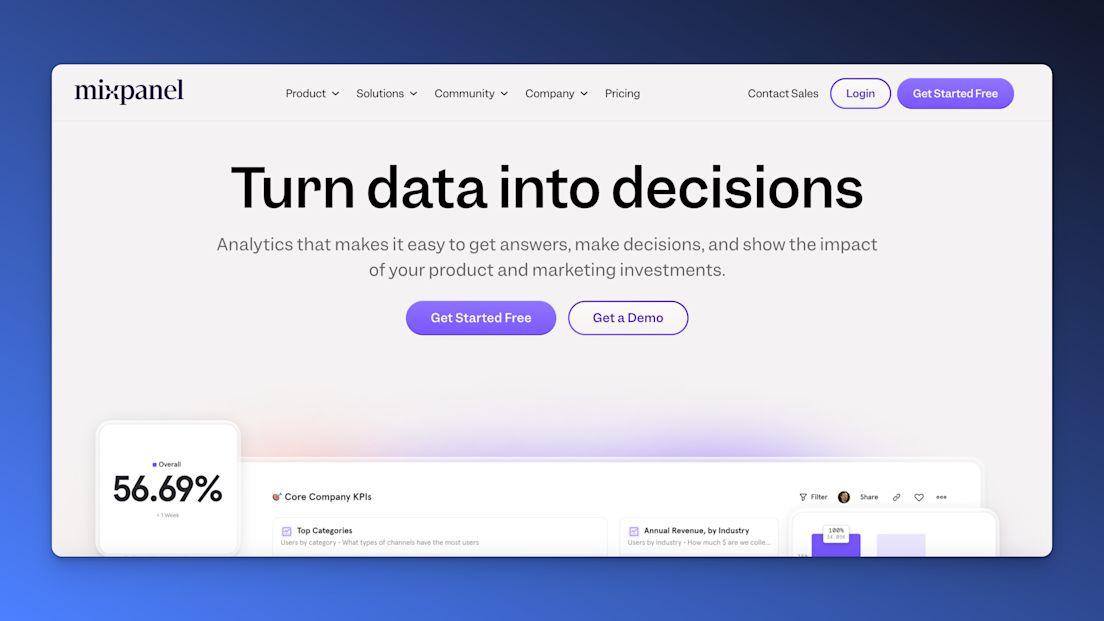

Best for: Event tracking and funnel analysis
Mixpanel is all about clarity through data. It helps you track specific user actions—like clicks, feature usage, or conversions—and analyze how those behaviors impact your KPIs.
The platform excels at creating funnels, retention reports, and user flows. You can slice data by cohort, segment, or time range to answer questions like: Are new users completing onboarding? or Which features drive repeat usage?
It’s ideal for fast-paced teams who need insights without waiting on data teams.
Top features:
Custom event tracking across product touchpoints
Conversion funnel analysis
Cohort retention breakdowns
Real-time dashboards and alerts
Lightweight setup and fast time-to-insight
Mixpanel Pricing: Free for up to 1M monthly events. Usage-based pricing starts after that. Enterprise plans available for higher volumes and support.
10. Amplitude
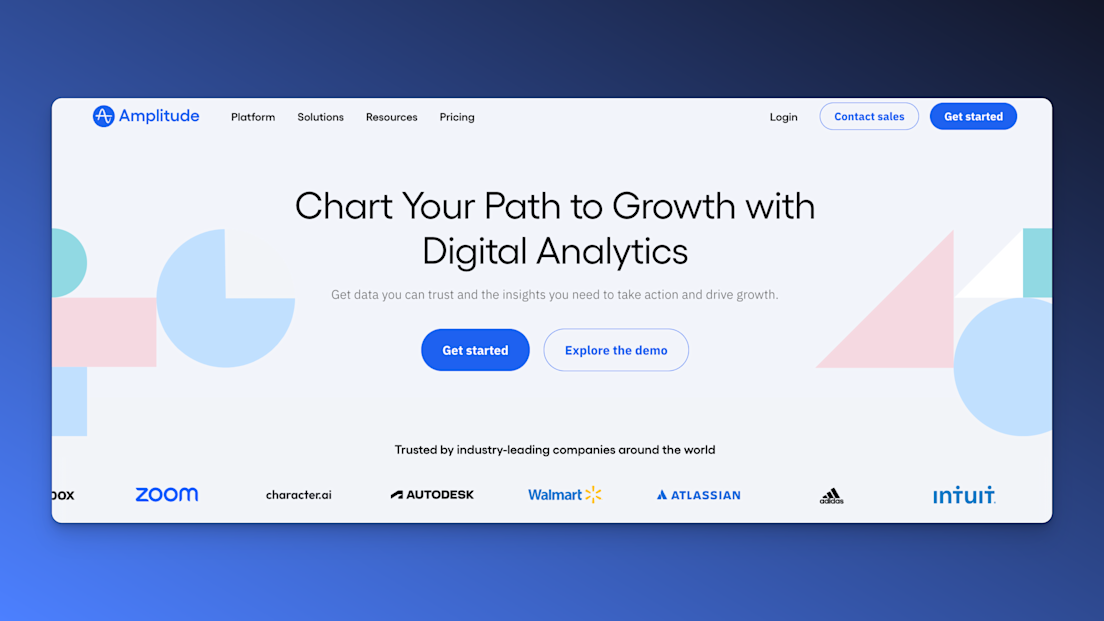

Best for: Connecting product usage to retention and revenue
Amplitude goes beyond tracking behavior, it helps you understand why it matters. By tying usage data to retention, monetization, and activation, Amplitude empowers teams to build features that move business metrics.
It’s especially strong in retention analysis and journey mapping. You can identify which actions predict long-term engagement, run A/B tests, and even analyze impact across user segments.
If your team is serious about product-led growth, Amplitude gives you the depth you need.
Top features:
Retention and cohort tracking
Journey analysis and path exploration
Revenue and conversion impact measurement
Segmentation and user properties
Built-in experimentation and feature flags
Amplitude Pricing: Starter plan is free (up to 50K users/month). Plus plan starts at $49/month. Custom pricing for Growth and Enterprise tiers.
UX Feedback Tools for Continuous Improvement
Sometimes, analytics alone isn’t enough. You also need to hear from your users—directly.
UX feedback tools help you collect, organize, and prioritize what users are saying. From feature requests to pain points, this input is gold when you’re trying to build a product that truly solves customer problems.
The best tools don’t just capture feedback—they help you make it actionable by connecting it to your roadmap and decision-making process.
Which feedback and UX tools capture user experience and feedback?
Here are two great tools to help you close the feedback loop and keep your product moving in the right direction.
11. Canny
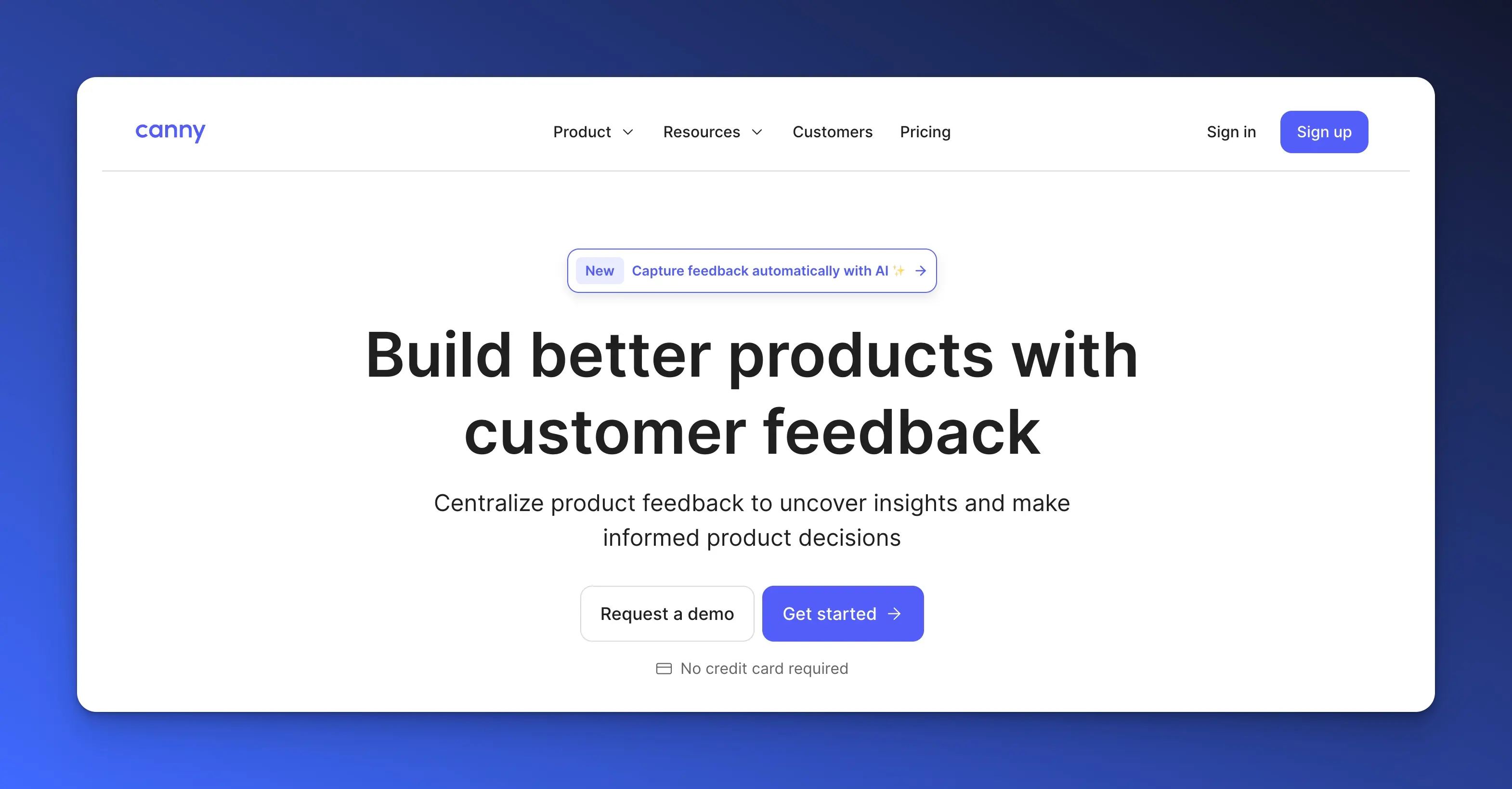
Best for: Crowdsourced feedback and feature request management
Canny helps you collect product feedback in a structured way—so it doesn’t get lost in Slack threads, emails, or scattered spreadsheets.
You create public or private boards where users can suggest ideas and vote on what they want most. Canny automatically surfaces the most requested features, helping you prioritize based on real demand.
It also lets you communicate progress to users with status updates like “Planned,” “In Progress,” and “Launched,” which builds trust and transparency.
Top features:
Public and private feedback boards
Upvoting system to highlight popular requests
Internal prioritization by customer segment or revenue impact
Status updates and changelog for user communication
Integrations with Jira, Intercom, and GitHub
Canny Pricing: Free for up to 100 posts. Paid plans start at $99/month. Growth and Enterprise plans available with advanced features and permissions.
12. Upvoty
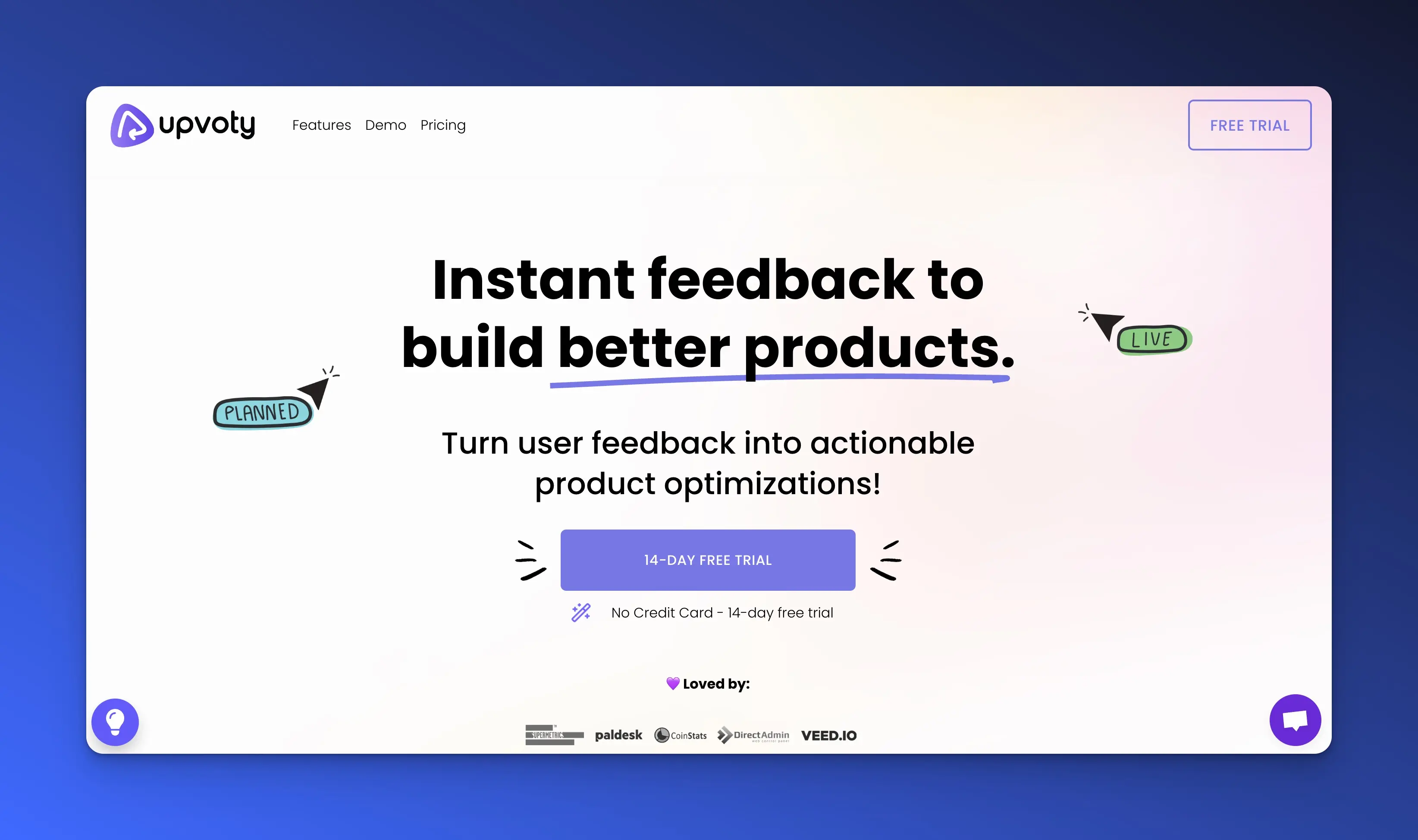
Best for: Lean feedback boards for growing teams
Upvoty is a lightweight and affordable feedback management tool designed for fast-moving product teams. It helps you collect suggestions from users, let them vote, and organize feedback by product or feature area.
One standout feature is the ability to embed your feedback board directly into your app or website. It makes it easy for users to share thoughts while they’re actively using your product.
Upvoty is ideal for startups or growing teams that want to stay close to customer needs without a complex setup.
Top features:
Embeddable feedback boards and widgets
Upvotes, comments, and changelog features
Multiple boards for different products or teams
Custom statuses and roadmap views
Lightweight UI with easy team adoption
Upvoty Pricing: Starts at $15/month (billed annually). Higher plans unlock unlimited boards, team members, and advanced integrations.
Roadmapping software to align teams and strategy
You’ve got ideas, you’ve got feedback, and you’ve got data. Now it’s time to build a plan everyone can see and get behind.
Roadmapping software helps you lay out your product vision clearly. These tools make it easy to prioritize features, set timelines, and align teams across design, engineering, and leadership.
A good roadmap isn’t just a list, it’s a strategic tool. It shows what’s coming, why it matters, and how everything connects to your business goals.
Which roadmapping software helps plan and communicate product strategy?
Here are three of the best product roadmap tools that help you align strategy with execution.
12. Productboard
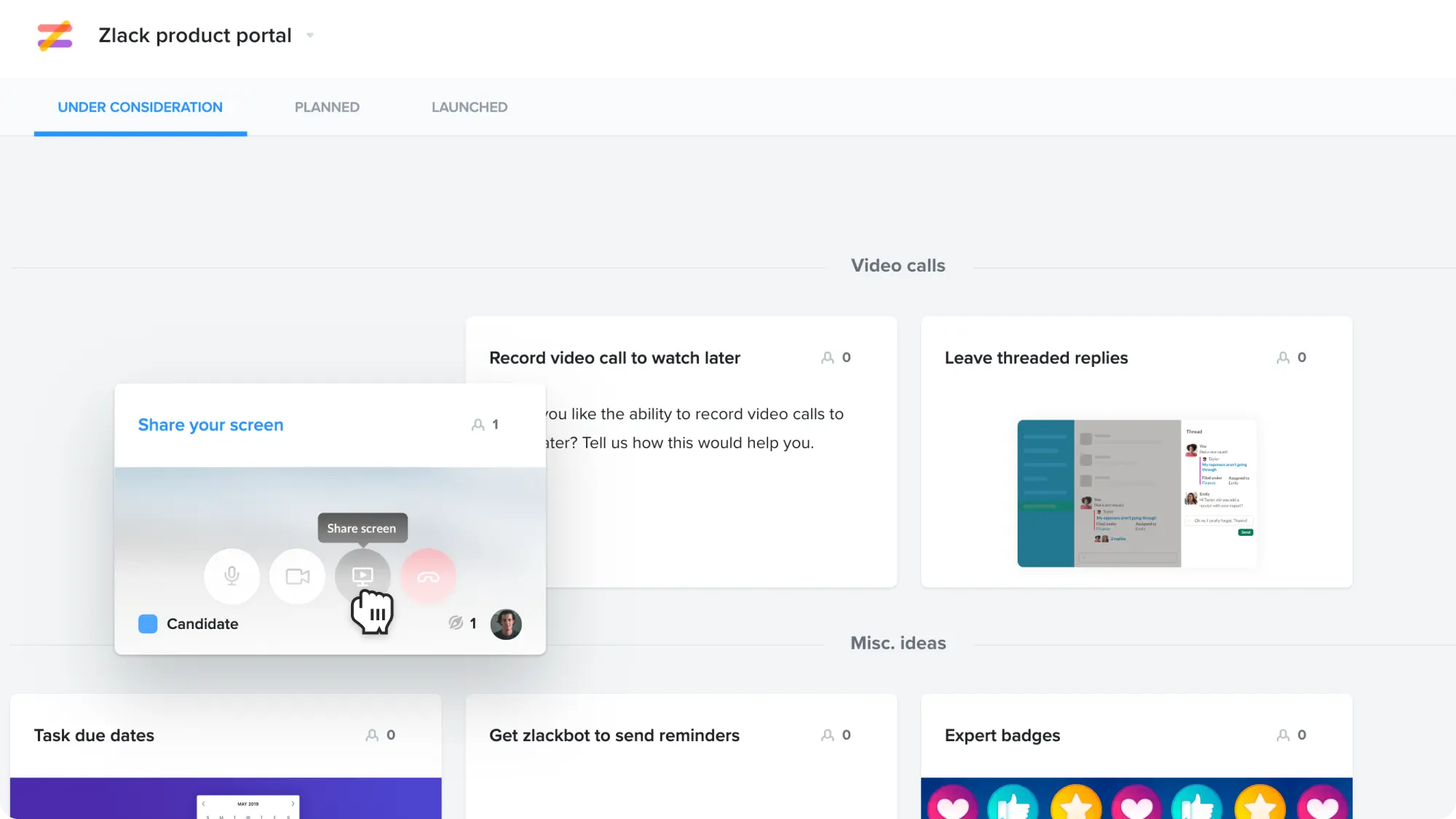
Best for: Prioritizing and planning with customer insights
Productboard brings clarity to the chaos. It helps you gather customer feedback, score feature ideas, and build a roadmap that actually reflects what users need.
You can link product decisions directly to feedback and objectives, helping your team stay customer-focused while staying on track. Productboard is ideal for teams that want to prioritize transparently and share roadmaps across departments.
Top features:
Centralized feedback linked to feature ideas
Custom prioritization frameworks (value vs. effort, RICE, etc.)
Multiple roadmap views for internal and external sharing
User segmentation and voting insights
Integrations with Jira, Intercom, Slack, and more
Productboard Pricing: Free “Starter” plan available. Essentials starts at $19/user/month. Pro at $59/user/month. Custom pricing for Scale and Enterprise tiers.
13. Aha! Roadmaps
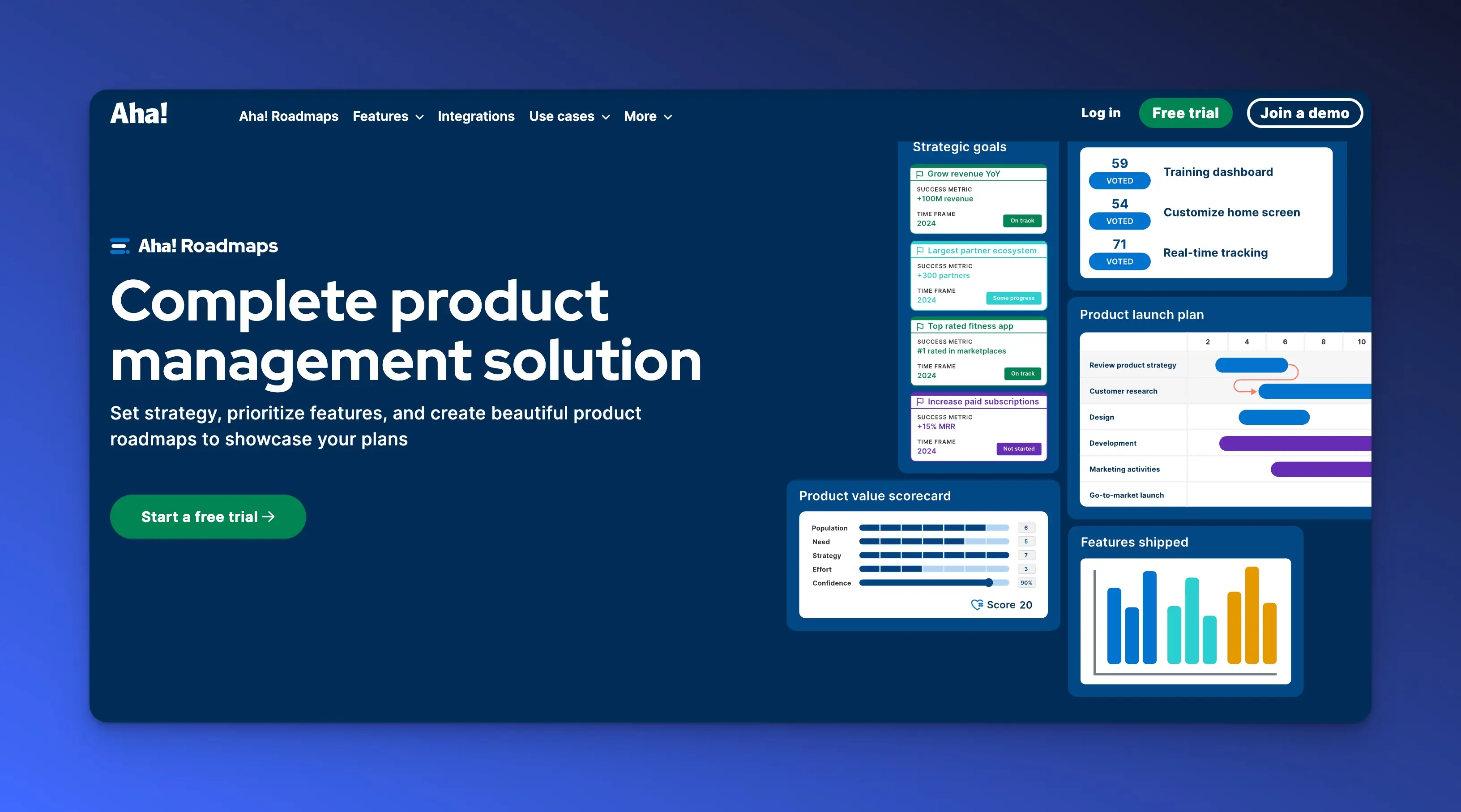
Best for: Strategic roadmapping for enterprise teams
Aha! Roadmaps is built for serious product planning. It helps you connect every feature and release to a broader vision, goal, or initiative—perfect for aligning product work with business strategy.
You can manage multiple products, track progress, crowdsource ideas, and plan capacity across teams. Aha! is powerful, and while it’s an investment, it’s worth it for companies managing complex portfolios.
Top features:
Goal, initiative, and release planning
Visual Gantt-style roadmaps and portfolio views
Capacity planning across teams
Customer ideas portal and feedback management
Strategy-first approach with rich reporting
Aha! Roadmaps Pricing: Starts at $59/user/month (Premium). Enterprise plan at $99/user/month. Enterprise+ at $149/user/month. Discounted startup plan available. Free trial offered.
14. ProductPlan
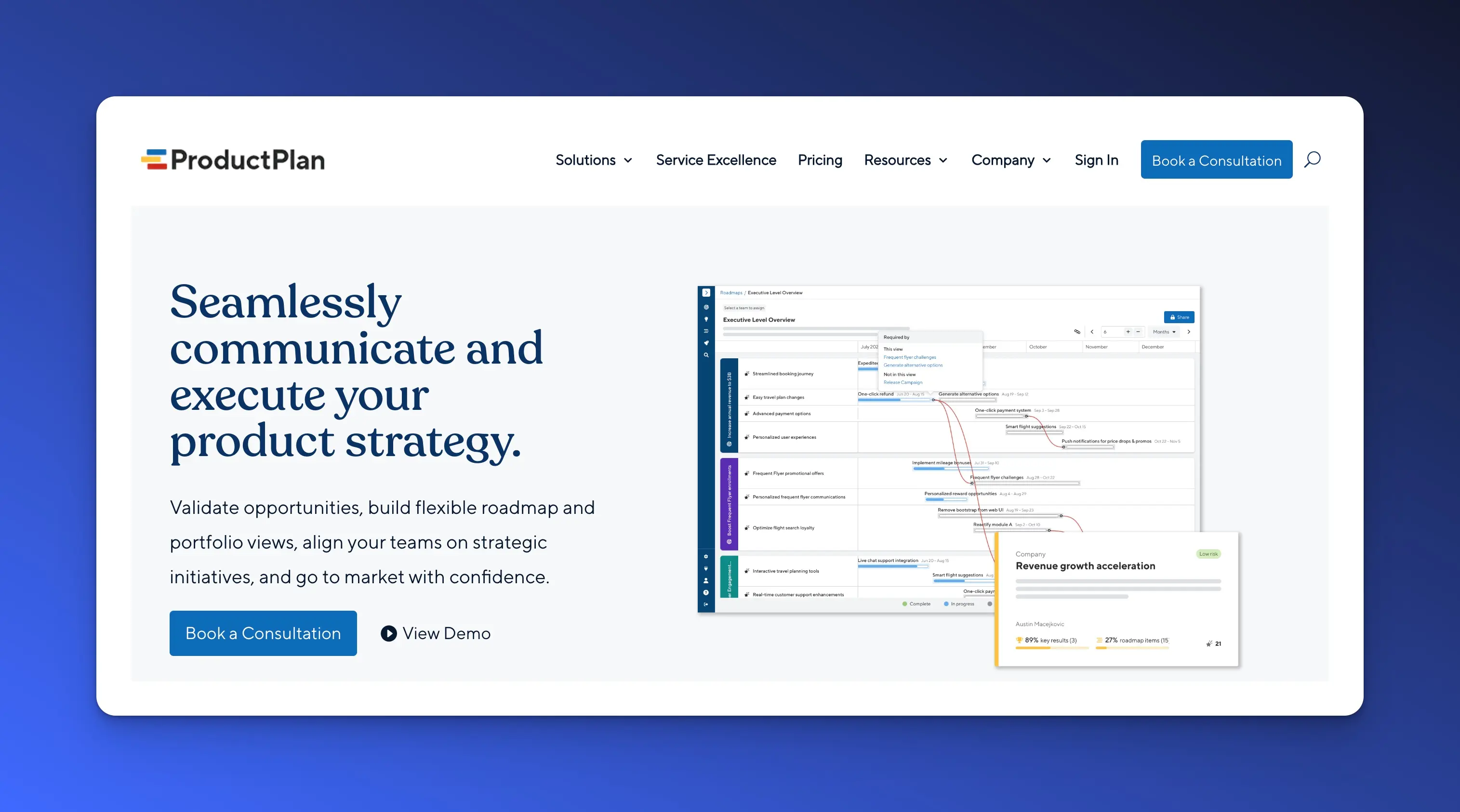
Best for: Easy visual roadmaps for all teams
ProductPlan is the go-to roadmap tool if you want to build and share clean, beautiful roadmaps without the learning curve.
It’s drag-and-drop simple, yet powerful enough for cross-functional collaboration. ProductPlan is great for teams who need to communicate plans clearly—whether that’s a monthly product update or a strategic roadmap for execs.
Top features:
Timeline and Kanban-style roadmap layouts
Color-coded lanes, tags, and initiatives
Easy sharing with unlimited viewers
Presentation mode and export options (PDF, PNG)
Integrations with Jira, Slack, Microsoft Teams
ProductPlan Pricing: Starts at $39/editor/month (billed annually). Professional plan at $69/editor/month. Enterprise pricing available for large teams.
How to choose the best product development tool
So how do you choose the best product development software for your team?
Choosing product development software isn’t just about picking what’s popular, it’s about finding what actually works for your team.
Let’s break it down so you can make smarter decisions without feeling overwhelmed.
1. Start by organizing your needs by category
Every product team works across a few key areas—so think in categories:
Project tracking (like Jira or Asana)
Product lifecycle management (PLM) (like Aras or Teamcenter)
New product development (NPD) (like ProdPad or Planview)
Product analytics (like UXCam or Amplitude)
User feedback and UX (like Canny or Upvoty)
Roadmapping (like Productboard or Aha!)
Start by asking yourself: Where are we struggling right now? Is your team losing track of tasks? Are you flying blind on what users actually do? Focus your tool search around the biggest gaps first.
2. Start small, then scale wisely
You don’t need to commit to a full tech stack overnight.
Many of the best product development tools offer free tiers or trials that let you test before you buy. Tools like Trello, Mixpanel, and UXCam let you get up and running fast without opening your wallet.
Try one tool in each category. See what actually helps your team move faster or work better. Once you know it’s adding value, you can upgrade or expand it later.
3. Build a stack that talks to each other
A bunch of great tools that don’t connect? That’s a headache waiting to happen.
Look for tools that integrate with your existing systems—whether that’s Jira, Slack, GitHub, or your analytics platform. For example:
Use UXCam to gather user insights that inform your Productboard roadmap
Link Jira issues directly to feedback from Canny or features in ProdPad
Sync Asana tasks with releases from Aha! or ProductPlan
The goal is to reduce manual work, keep teams aligned, and create a seamless flow of information across the product lifecycle.
4. Tailor tools to how your team actually works
Even the most powerful tool is useless if your team won’t use it.
So before you buy anything, ask: Does this tool fit how we already work? Can my team learn it quickly? Does it make life easier or just more complicated?
Choose tools that feel natural to your team’s workflow. Focus on simplicity, clarity, and collaboration. And always involve a few team members in testing before rolling out anything new.
Conclusion
Product development is a team sport and the right tools are your competitive edge.
Whether you’re refining your roadmap, capturing feedback, or analyzing user behavior, each tool in your stack should help your team work smarter, not harder.
You don’t need the biggest or most expensive tools, you need the ones that fit your workflow, scale with your team, and give you clarity at every stage of the product journey.
If you're ready to turn user behavior into better product decisions, UXCam is a great place to start.
With session replays, funnel insights, and powerful mobile + web analytics, UXCam helps you see what users are really doing—so you can improve experiences faster.
Start your free trial of UXCam today and get a front-row seat to your user journey. No guesswork. No credit card. Just insights that drive better products.
FAQs
Product Development Software FAQs
What is product development software?
Product development software refers to digital tools that help product teams plan, build, launch, and improve products throughout their lifecycle. These tools centralize workflows such as idea management, project tracking, roadmapping, collaboration, and product analytics, allowing teams to align around customer needs and business goals.
What are the main benefits of using product development software?
Using product development software brings several advantages, including better team alignment, faster decision-making, and improved product quality. It helps teams prioritize the right features, track real user behavior, gather actionable feedback, and communicate roadmaps clearly across the organization. The result is more efficient collaboration, reduced errors, and a shorter time to market—all of which contribute to building better products with fewer surprises.
What are the key capabilities of product development software?
Product development software typically includes capabilities such as centralized task tracking, roadmap planning, user feedback collection, and product performance analytics. It supports collaboration across teams, automates workflows, manages version control, and ensures everyone is working with up-to-date product data. These tools help guide a product from idea to launch and beyond, while keeping teams aligned and informed.
What are some examples of product development software?
Popular examples of product development software include tools like Jira for agile task management, Productboard for roadmapping and prioritization, UXCam for mobile and web user analytics, and Canny for customer feedback. Other widely used options are Mixpanel for behavioral analytics, Aha! for strategic planning, and Trello for visual Kanban-style tracking. Each tool focuses on a specific part of the product development process and is often used in combination with others.
What is the difference between project management and product development software?
Project management software focuses on task execution—who is doing what and by when. Product development software includes project management features but extends further into product strategy, customer feedback, analytics, and cross-functional planning. It supports the full lifecycle of building and improving a product, not just the delivery.
You might also be interested in these;
13 Best Product Management Tools & When to Use Them
Product Management and User Experience - How to Collaborate Effectively
Product Hypothesis - A Guide to Create Meaningful Hypotheses
Practical Guide to Product Management Analytics
Product Strategy Framework - 9 Steps to Create a Winning App
AUTHOR

Tope Longe
Product Analytics Expert
Ardent technophile exploring the world of mobile app product management at UXCam.
What’s UXCam?
Related articles
Session Replay
Mobile Session Recording - The Complete Guide 2026
Why session replay is such a valuable feature, and what you should look out for when starting...

Annemarie Bufe
Product Analytics Expert
Product Management
14 Best Product Development Software for Every Team 2025
Discover the 14 best product development software tools to streamline collaboration, track progress, collect feedback, and build better products...

Tope Longe
Product Analytics Expert
Product Management
13 Best Product Management Tools 2025 & When to Use Them
Find out the top tools that the best product managers use daily to perform better at...

Jane Leung
Product Analytics Expert
